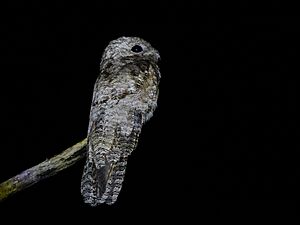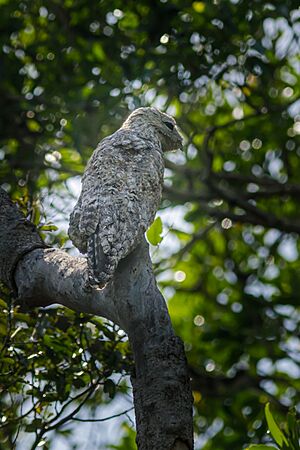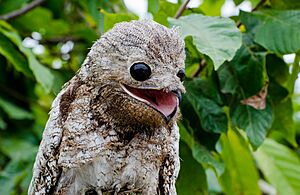Great potoo facts for kids
Quick facts for kids Great potoo |
|
|---|---|
 |
|
| in Apiacás, Mato Grosso, Brazil |
|
| Conservation status | |
| Scientific classification | |
| Genus: |
Nyctibius
|
| Species: |
grandis
|
 |
|
The Great Potoo (Nyctibius grandis) is the biggest type of potoo bird. You can find it across many parts of Central and South America.
Like owls, these birds are active at night. They hunt large insects and small animals. They catch their prey by swooping down from high branches. The Great Potoo is famous for its unique, deep call. It makes this sound all night long, which can create a mysterious feeling in the Neotropics.
Contents
What is a Great Potoo?
The Great Potoo was officially named in 1789. This was done by a German scientist named Johann Friedrich Gmelin. He first put it in the same group as nightjars. Later, in 1816, it was moved to its own group, Nyctibius. The name Nyctibius comes from ancient Greek words. It means "night-living." There are no different types or subspecies of the Great Potoo.
Amazing Features of the Great Potoo
The Great Potoo has a very large head compared to its body. Its eyes are also very big and dark brown. Many other potoo birds have yellow eyes. It has a short but wide beak. Their wings are shaped like an oval, and their tail is long.
Their feathers come in colors like white, gray, black, and reddish-brown. The tail feathers match the body. They also have white stripes across their tail.
Here are some facts about their size:
- They usually weigh between 360 to 650 g (13 to 23 oz).
- They are about 480 to 600 mm (19 to 24 in) long.
- Their wingspan can be from 700 to 804 mm (27.6 to 31.7 in).
- On average, their wingspan is about 734.8 mm (28.93 in).
Where Do Great Potoos Live?
Great Potoos live in many places. Their home ranges from southern Mexico to northeastern Guatemala. They are found throughout most of Central America. They also live in South America, reaching as far as southeastern Brazil and Bolivia.
These birds mostly live in forests that are humid or semi-humid. Even though they are spread out, they all look very similar. Their size and feather colors do not change much. Great Potoos prefer thick lowland forests. They also live at the edges of forests and in clearings. You might find them in foothills up to about 1,500 meters high. They can also be in open woodlands, including plantations. Sometimes, they are seen near meadows. However, they always need trees for their amazing camouflage.
During the day, they usually perch or nest high up in big trees. They often choose branches that are 20 to 30 centimeters wide. These branches are usually higher than 12 meters off the ground. At night, they might move to lower branches, about 1.5 meters high. They hunt from these lower spots.
How Do Great Potoos Behave?
The Great Potoo is a predator that hunts at night. During the day, it usually sits very still on a tree stump. It looks so much like part of the stump that people often don't notice it. This is a special kind of camouflage. It's not just their colors, but also how they sit.
At night, you can sometimes find a Great Potoo by shining a light. Their eyes will reflect the light as they sit upright. They might be on a post, a branch, or a slanted tree trunk. Great Potoos are shy birds and usually live alone.
Hunting at Night
When hunting, the Great Potoo sits high up. It waits for prey to fly by. Once it spots something, it quickly flies out to catch it. Then, it almost always returns to the same branch. These birds often use the same hunting spot every night.
Reproduction and Life Cycle
Great Potoos usually breed from February to August. However, in some areas, they might breed almost all year. Their nest is a small dip on a thick tree branch. This branch is usually at least 10 m (33 ft) above the ground.
The female lays a single white egg. It might have a few spots. The egg is about 5.2 cm × 3.8 cm (2.0 in × 1.5 in) in size. We don't know many details about how they care for their eggs. But, it takes about a month before the baby bird is seen alone at the nest. A chick that is a few days old can weigh 220 g (7.8 oz).
After about 5 weeks, the young bird looks like two-thirds of an adult. It is lighter and has paler feathers. Its tail is shorter, and its beak is smaller. The young bird stays in the nest for at least 2 months. After this time, the young birds do not come back to the nest.
Adult potoos likely have few natural enemies. However, their eggs and young birds are often eaten by other animals. Adult potoos stay near the nest all day. They use their camouflage to protect their babies. Animals that might eat potoo nests in Costa Rica include mantled howler monkeys, Geoffroy's spider monkeys, and white-headed capuchins. Tayras and collared forest falcons might also be predators.
What Do Great Potoos Eat?
Great Potoos mainly eat large flying insects. This includes big beetles, katydids, and other Orthoptera (like crickets and grasshoppers). Sometimes, they also catch bats and small birds. The Great Potoo uses the darkness of night and its natural camouflage. It sits on an open branch and waits. When prey flies by, it quickly darts out to catch it. Then, it returns to its branch with the meal.
Protecting the Great Potoo
The Great Potoo is listed as a species of "least concern" by the International Union for Conservation of Nature (IUCN). This means it is not currently in danger of disappearing. It is described as "uncommon." However, it is often found in forests that have not been disturbed much. It is sometimes rare at the edges of its habitat. The biggest threat to this bird is when forests are cut down.
Effects of Humans
In some rural areas of Brazil, local people sometimes hunt potoos for food. They don't offer much meat, and they are hard to find. In these areas, some local people believe that parts of the potoo have special powers. These parts are sometimes used in ceremonies. Because they are hunted, potoos are often afraid of people.




